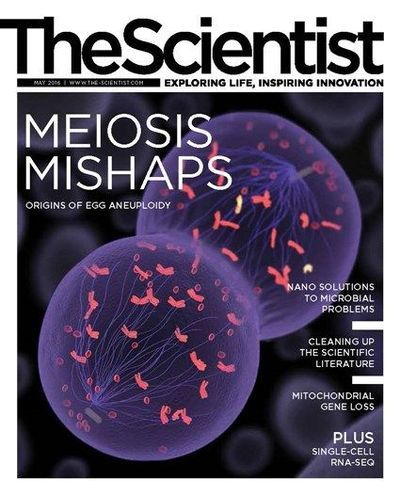Login
SubscribeCover Story

A Scrambled Mess
Karen Schindler | May 1, 2016 | 10+ min read
Why do so many human eggs have the wrong number of chromosomes?
Features

Nanoscale Defenses
Edward D. Marks and Steven Smith | May 1, 2016 | 10 min read
Coating hospital surfaces, surgical equipment, patient implants, and water-delivery systems with nanoscale patterns and particles could curb the rise of hospital-acquired infections.

The Zombie Literature
Bob Grant | May 1, 2016 | 10 min read
Retractions are on the rise. But reams of flawed research papers persist in the scientific literature. Is it time to change the way papers are published?
Contributors
Contributors
Contributors
Meet some of the people featured in the May 2016 issue of The Scientist.
Editorial
Transparency Now
Transparency Now
Science is messy. So lay it out, warts and all.
Speaking of Science
Speaking of Science
Speaking of Science
May 2016's selection of notable quotes
Notebook
Serious Putty
Serious Putty
A naturally occurring clay, used in traditional Native American medicine, shows promise as an antibiotic.
What’s in a Voice?
What’s in a Voice?
More than you think (or could make use of)
Silent Canopies
Silent Canopies
A spate of howler monkey deaths in Nicaragua, Panama, and Ecuador has researchers scrambling to identify the cause.
Feeling Around in the Dark
Feeling Around in the Dark
Scientists work to unlock the genetic secrets of a population of fruit flies kept in total darkness for more than six decades.
Thought Experiment
The Shrinking Mitochondrion
The Shrinking Mitochondrion
Scanning the mitochondrial genomes of thousands of species is beginning to shed light on why some genes were lost while others were retained.
Critic at Large
The Global Science Era
The Global Science Era
As international collaboration becomes increasingly common, researchers must work to limit their own biases and let cultural diversity enhance their work.
Modus Operandi
Sensors for All
Sensors for All
A versatile modular strategy for detecting small molecules in eukaryotes
The Literature
Kissing Cousins
Kissing Cousins
Researchers discover a completely novel mechanism of cell signaling involving soluble chemokines and their transmembrane equivalents.
Aneuploid Responses
Aneuploid Responses
A recent exchange of papers is divided over the evidence for compensatory gene expression among wild strains of aneuploid yeast.
Animal Magnetism
Animal Magnetism
A photosensitive protein behind the retinas of cockroaches plays a role in light-dependent, directional magnetosensitivity.
Profile
More Than Skin Deep
More Than Skin Deep
Elaine Fuchs has worked on adult stem cells since before they were so named, figuring out how multipotent epidermal cells renew or turn into skin or hair follicles.
Scientist to Watch
Timothy Lu: Niche Perfect
Timothy Lu: Niche Perfect
Associate Professor, Departments of Electrical Engineering & Computer Science and Biological Engineering, MIT. Age: 35
Lab Tools
Becoming Acculturated
Becoming Acculturated
Techniques for deep dives into the microbial dark matter
Scaling to Singles
Scaling to Singles
Tips for tracing transcription in individual cells
Careers
Making the Most of School
Making the Most of School
Agencies and institutions strive to better prepare graduate students and postdocs for futures in academia and beyond.
Reading Frames
To Each Animal Its Own Cognition
To Each Animal Its Own Cognition
The study of nonhuman intelligence is coming into its own as researchers realize the unique contexts in which distinct species learn and behave.
Capsule Reviews
Capsule Reviews
Capsule Reviews
Sorting the Beef from the Bull, Cheats and Deceits, A Sea of Glass, and Following the Wild Bees
Foundations
Picturing Inheritance, 1916
Picturing Inheritance, 1916
This year marks the centennial of Calvin Bridges’s description of nondisjunction as proof that chromosomes are vehicles for inheritance.





















